-
Paper Information
- Next Paper
- Previous Paper
- Paper Submission
-
Journal Information
- About This Journal
- Editorial Board
- Current Issue
- Archive
- Author Guidelines
- Contact Us
American Journal of Condensed Matter Physics
p-ISSN: 2163-1115 e-ISSN: 2163-1123
2012; 2(5): 120-125
doi: 10.5923/j.ajcmp.20120205.03
Mass Quadrupole Spectrometry for Infrared Laser-Generated Plasmas Detection
F. Caridi 1, 2, L. Torrisi 1, 3, C. Scolaro 1, 2, M. Cutroneo 1, 2
1Dip.to di Fisica e Scienze della Terra, Viale F. Stagno d’Alcontres, 31, 98166, Messina, Italy
2INFN-Sez. CT, Gruppo coll. di Messina, Viale F. Stagno d’Alcontres, 31, 98166, Messina, Italy
3INFN-Laboratori Nazionali del Sud, Via S. Sofia 44, Catania, Italy
Correspondence to: F. Caridi , Dip.to di Fisica e Scienze della Terra, Viale F. Stagno d’Alcontres, 31, 98166, Messina, Italy.
| Email: |  |
Copyright © 2012 Scientific & Academic Publishing. All Rights Reserved.
A nanosecond pulsed Nd:YAG laser, operating at the fundamental wavelength of 1064 nm and at an intensity of about 1010 W/cm2, was employed to irradiate the Cu0.4W0.6 metallic alloy and the relative pure components (Cu and W) in vacuum to investigate about the ablation. Produced plasmas were characterized in terms of thermal and Coulomb interactions evaluating the equivalent temperatures and acceleration voltages developed in the non-equilibrium plasma core. The particles emission, produced along the normal to the target surface, was investigated by measuring, with the special electrostatic mass quadrupole spectrometer Hiden EQP 300, neutral and ion energy distributions and fitting experimental data with the “Coulomb-Boltzmann-shifted” function. Results indicated that the metal alloy stoichiometry, in a first approximation, is well transported to the ion and neutral stoichiometry of the plasma.
Keywords: Cu-W Alloy, Infrared Laser-Generated Plasma, Neutral , Ion Energy Distributions, Mass Quadrupole Spectrometry
Cite this paper: F. Caridi , L. Torrisi , C. Scolaro , M. Cutroneo , "Mass Quadrupole Spectrometry for Infrared Laser-Generated Plasmas Detection", American Journal of Condensed Matter Physics, Vol. 2 No. 5, 2012, pp. 120-125. doi: 10.5923/j.ajcmp.20120205.03.
Article Outline
1. Introduction
- Intense pulsed laser beams focused on a solid material produce ablation and formation of hot non-equilibrium plasmas, which have been used for several applications in these last years, such as deposition of thin films, generation of ions at high energy and charge state, treatment of surfaces, ion implantation, medical applications, etc.[1, 2]. Energetic plasma ions permit to induce ion implantation effects in the exposed surfaces, improving the film-substrate adhesion, to induce activation and growth of nanostructures, such as carbon nanotubes and fullerenes[3]. Energetic neutral emission determines the fractional ionization of the plasma and play an important role in the plasma properties (temperature, density, ion neutralization, charge exchange, ionization processes, etc.).Processes developed inside the laser-generated plasma are very complex and depend on many different parameters, such as the laser intensity, target composition, irradiation conditions, etc. Thus, for their description, many effects, such as optical absorption, heat conduction, phase transitions, fluid dynamics, inverse Bremmstrahlung and self-focusing, were introduced[4]. Although these plasmas are in non-equilibrium conditions and not really thermalized, the concept of ‘‘equivalent temperature”, referred to ions, electrons and neutrals in near local thermal equilibrium (NLTE) conditions, is employed in order to characterize the plasma properties, as reported in literature[5].In this work a 3 ns Nd:YAG laser operating in the infrared region with relatively high pulse energy is employed to irradiate copper, tungsten and the alloy of 40% Cu and 60% W, in vacuum. Obtained plasmas are investigated in terms of neutral and ion emission. The aim is to investigate about the ablation, in order to know if the alloy stoichiometry is maintained in the plasma ion and neutral components, in the case of two metals having very different physical and chemical properties.
2. Materials and Methods
- The employed laser is a Q-switched Nd:Yag pulsed laser, operating at 1064 nm wavelength, 3 ns pulse duration, 1–180 mJ pulse energy, in single pulse or repetition rate (1-10 Hz) mode. The laser beam is focused through a convergent lens on the solid target placed inside a vacuum chamber at 10-6 mbar. The optimum focalization distance (50 cm) was determined minimizing the spot dimension observed on the target. The spot diameter is about 1 mm and the incidence angle is 45°. This angle can be changed by the operator moving a vacuum feedthrough at which the target holder is fixed.The employed targets consist of pure Cu and W sheets and an alloy of 40% Cu and 60% W, with a polished 1 cm2 surface and 1 mm thickness. They can be moved vertically with the vacuum feedthrough, so that each laser shot can hit a fresh flat surface.A special electrostatic mass quadrupole spectrometer, the so-called Electrostatic Quadrupole Plasma (EQP Hiden 300), was employed to monitor particles ejected from the plasma along the target normal surface, with a mass range within 1 and 300 amu. The instrument detects neutrals and charged particles depending on the filament state (with filament “on” neutrals and ions are both detected while with filament “off” only ions are detected). The charge state is monitored through the mass-to-charge ratio measurement performed by an electrostatic ion deflection. It measures the particle energy with an accuracy of 1 eV and plots the energy distribution of neutral and charged species in the energy range 1 eV–1 keV. The spectra acquisition occurs operating at 10 Hz laser repetition rate, and it is triggered with the laser shot. EQP uses a 45° electrostatic deflection, in order to measure the ion energy, and a differential pumping at 10-7 mbar pressure. The instrument consists of four main sections: the ionisation source; the electrostatic energy filter; the mass filter; the secondary electron multiplier (SEM) detector. More details on the EQP instrument are reported in the literature[6].
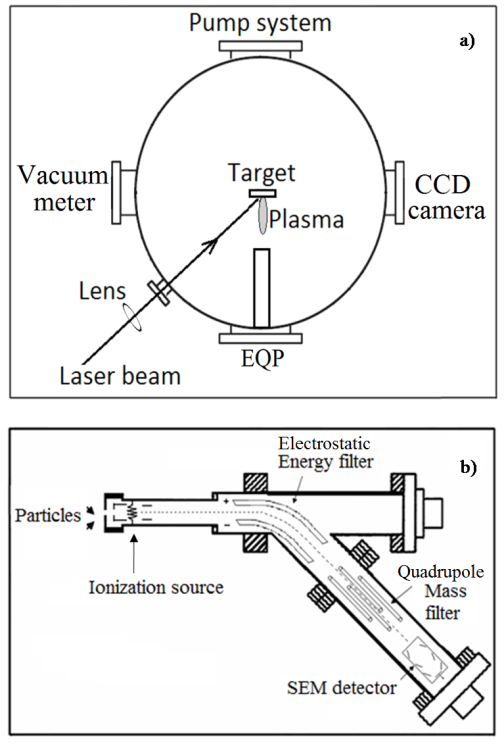 | Figure 1. A plot of the experimental setup (a) and a scheme of the EQP detector (b) |
 | (1) |
3. Results and Discussion
- Figure 2 shows a comparison of crater profiles obtained irradiating with 50 laser shots, 1 Hz, three employed targets (Cu, W and Cu0.4W0.6) in the same experimental conditions, at 0° incidence angle and 180 mJ pulse energy. The ablation yield was calculated through the crater volume and the target density (ρCu = 8.9 g/cm3, ρW = 19.3 g/cm3, ρCu0.4W0.6 = 12.75 g/cm3), giving a value of 2.4x1016/pulse and 1.27x1016/pulse for Cu and W, respectively, while for the alloy Cu0.4W0.6 an intermediate value of 1.67x1016/pulse was obtained. Figure 3 shows typical EQP spectra obtained ablating Cu (a) and Cu0.4W0.6 (b) targets and detecting copper at 180 mJ pulse energy, 10 Hz repetition rate, 45° incidence angle and 0° detection angle. Spectra report the yield signal versus particle energy for neutral and ionized atoms. The fit of experimental data (points) indicates that particles have typical Boltzmann distributions, peaked at different energies depending on their charge state. In particular, Cu neutrals are peaked at energies of about 35 eV and 46.5 eV for Cu and Cu0.4W0.6 targets, respectively, demonstrating that Cu particles energies increase in presence of W, due to the higher electron density of the produced plasma. Neutrals energy distributions contain direct information on the plasma temperature. Along the normal to the target irradiation this energy is due to two different contributions: the first is due to the thermal energy, ET = 3kT/2 and the second to the adiabatic expansion energy, EK = γkT/2, where k is the Boltzmann constant, T is the temperature, and γ is the adiabatic coefficient (1.67 for monoatomic species). The fit of experimental spectra indicates that the temperature for Cu and Cu0.4W0.6 plasmas is 15 eV and 20 eV, respectively, demonstrating that it increases in presence of W due to the increase of the plasma electron density. Ion energy distributions contain information not only about the temperature but also about Coulomb interactions. In this case, in fact, a third contribution is involved in the total ion energy; this is the Coulomb energy, EC = zeV0, where ze is the ion charge and V0 is the equivalent acceleration voltage developed inside the non-equilibrium plasma. First ionized Cu atoms are peaked at about 112 eV and 136 eV for Cu and Cu0.4W0.6 plasmas. Cu ions with higher charge states have a regular energy shift of about 75 eV and 90 eV for Cu and Cu0.4W0.6 targets, respectively, for a total number of 4 and 8 charge states, respectively. All experimental data are reported in Table 1.
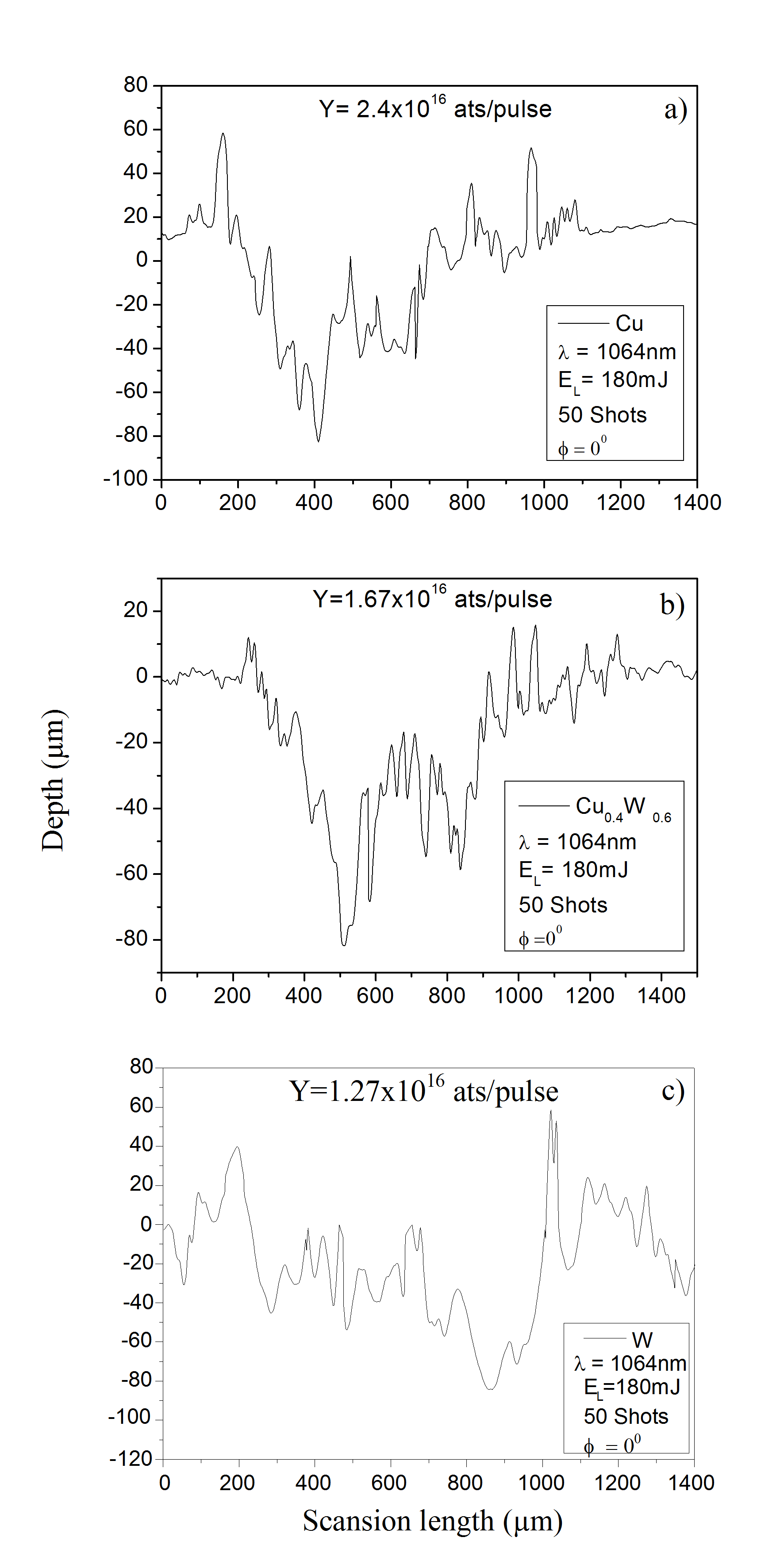 | Figure 2. A comparison of crater profiles obtained irradiating with 50 laser shots three employed targets (Cu, Cu0.4W0.6 and W ) |
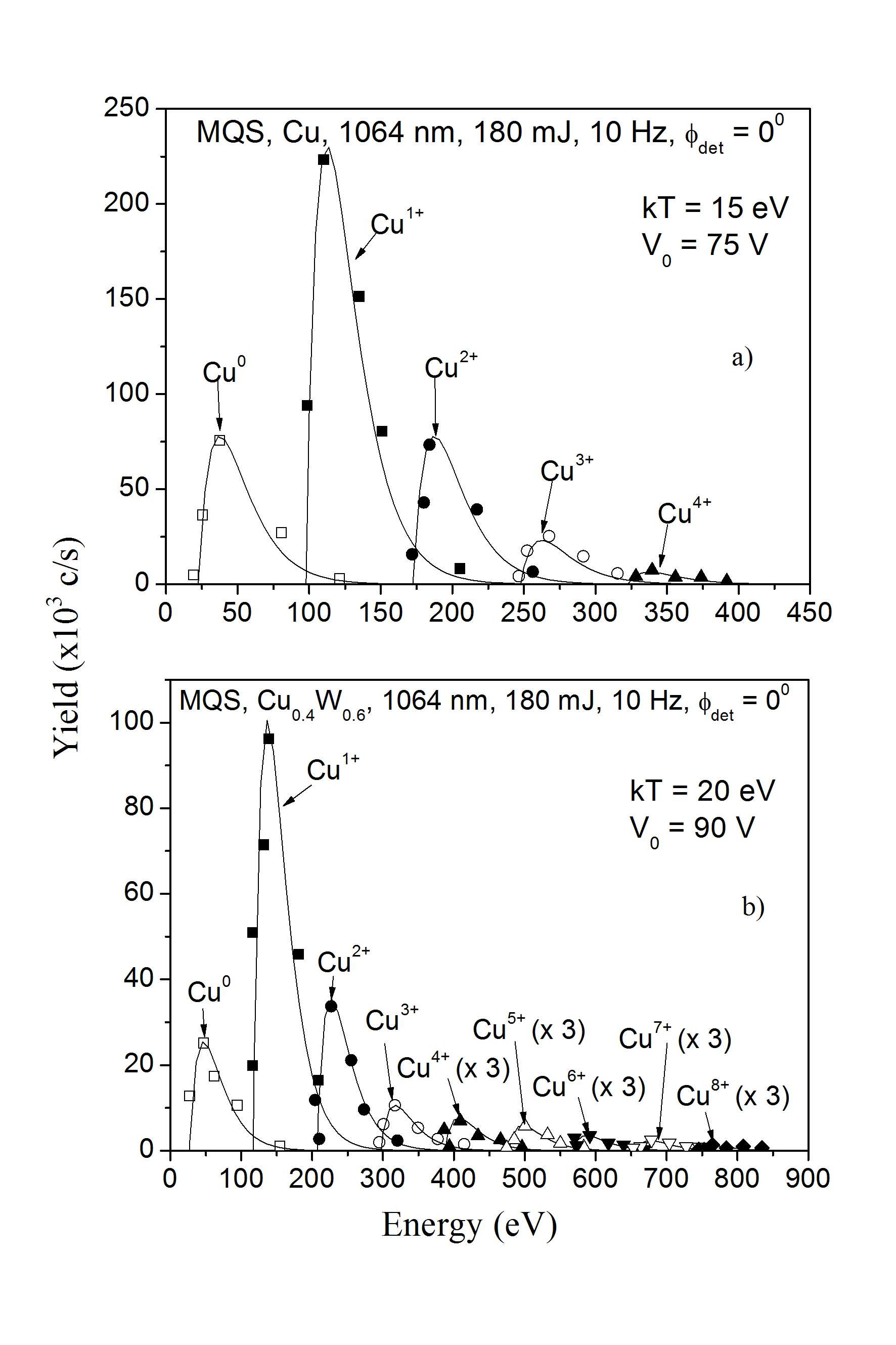 | Figure 3. Typical EQP spectra obtained ablating Cu (a) and Cu0.4W0.6 (b) targets and detecting copper |
|
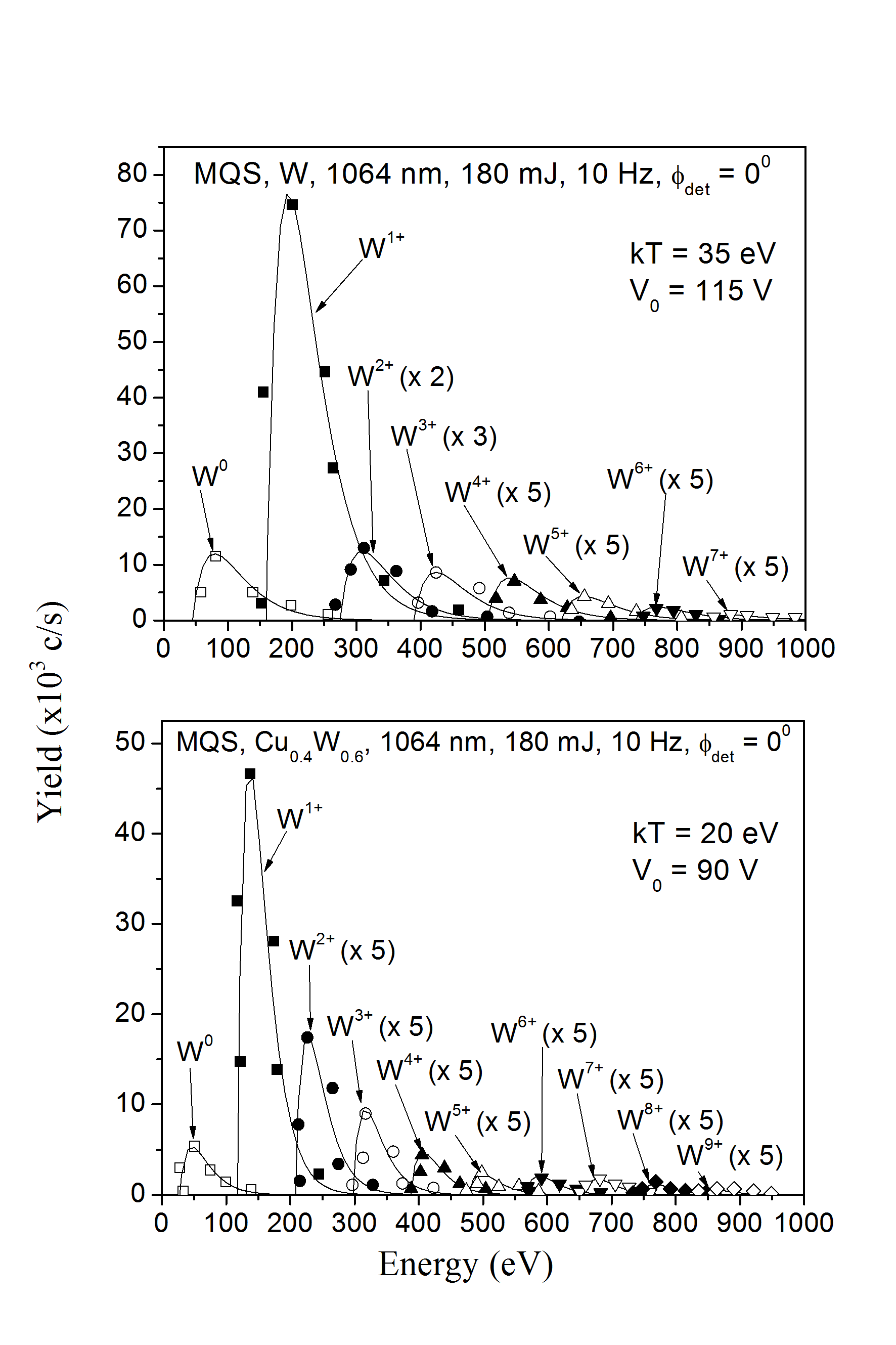 | Figure 4. Typical EQP spectra obtained ablating W (a) and Cu0.4W0.6 (b) targets and detecting tungsten |
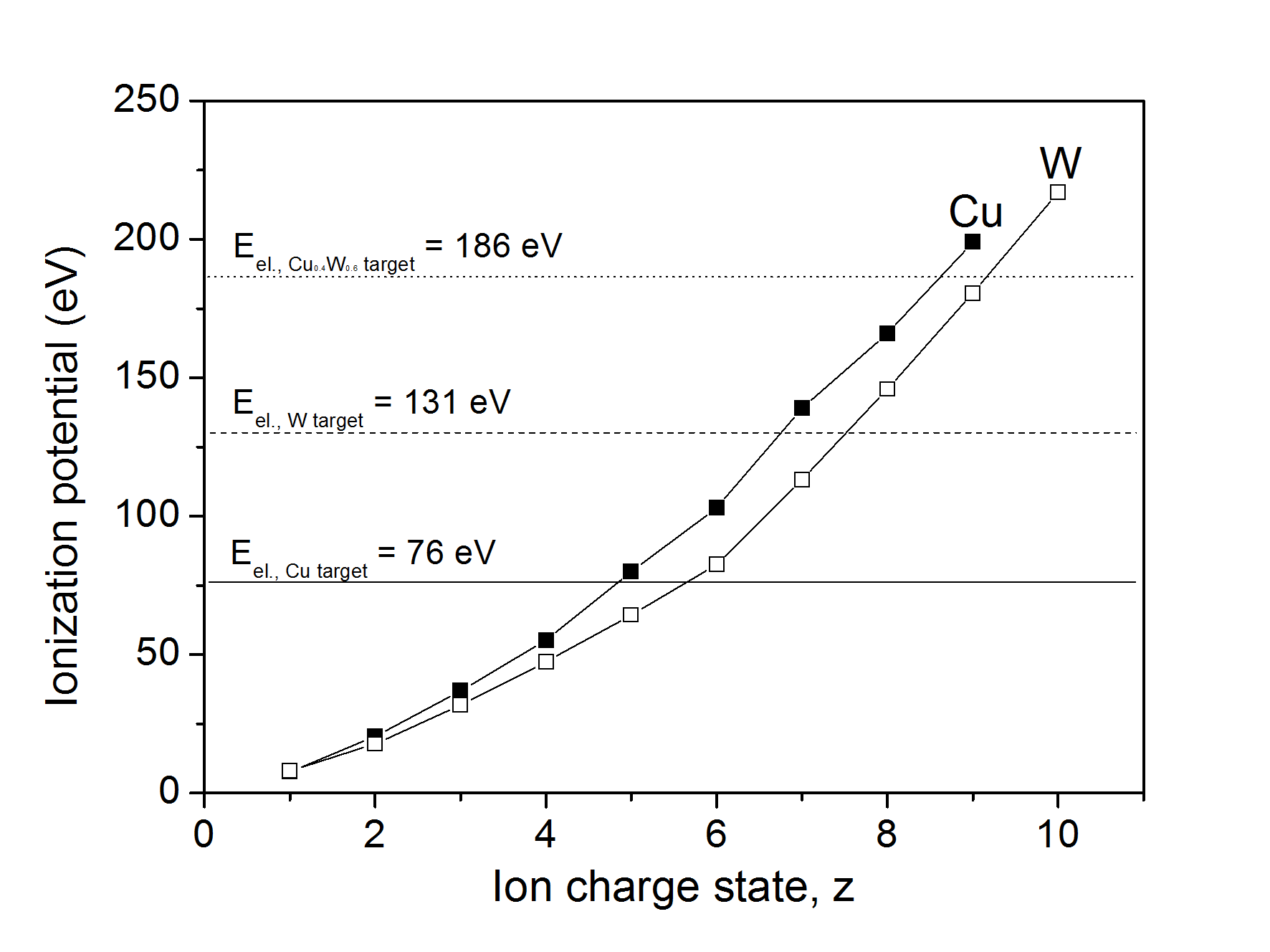 | Figure 5. The ionization potential as a function of the ion charge state for the ablated targets |
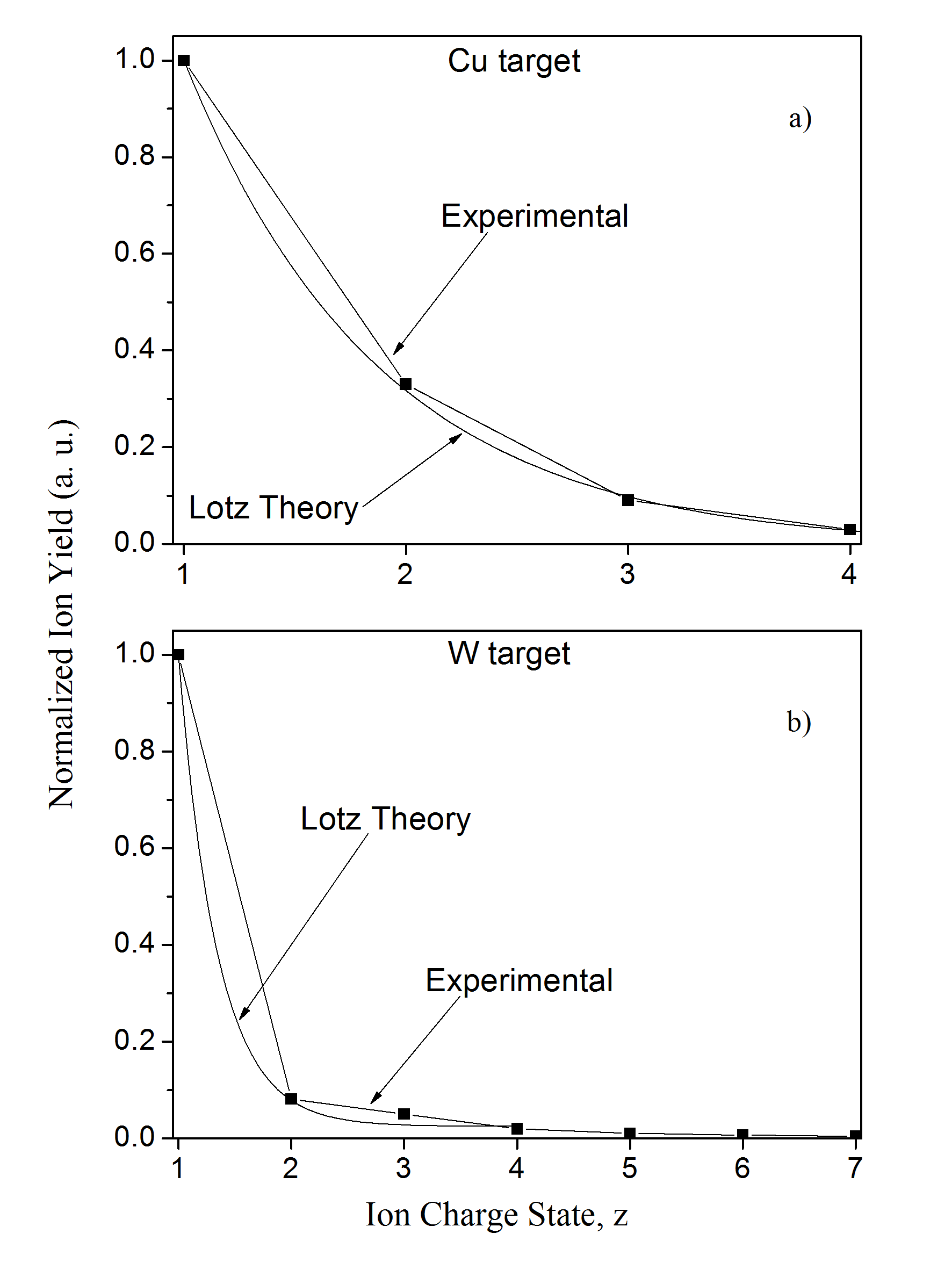 | Figure 6. The comparison for EQP ion data elaboration for Cu (a) and W (b) targets, respectively |
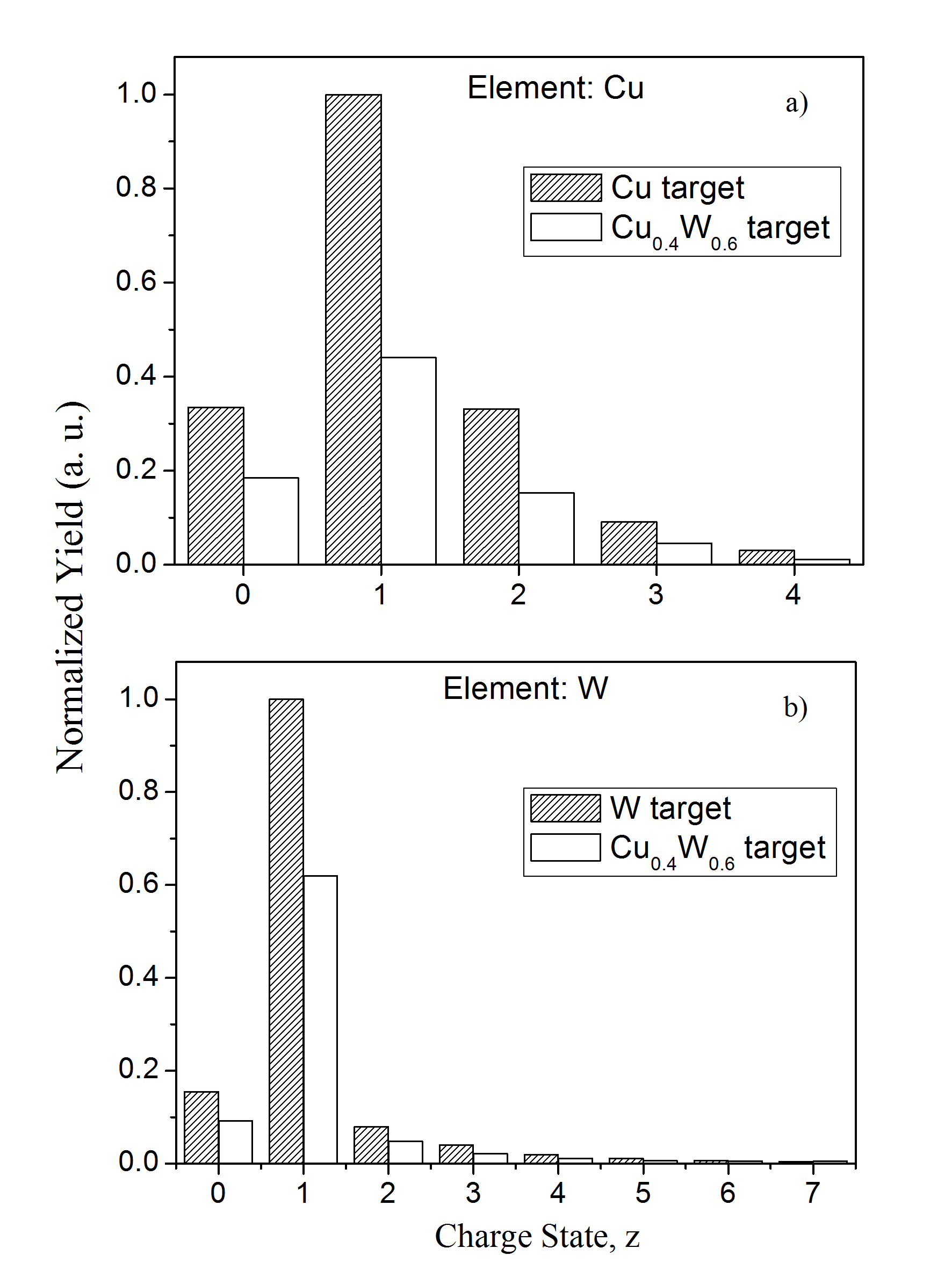 | Figure 7. A comparison between the normalized neutral and ion yields for copper (a) in Cu and Cu0.4W0.6 targets, respectively, and for tungsten (b) in W and Cu0.4W0.6 targets, respectively |
4. Conclusions
- The laser ablation of Cu, W and Cu0.4W0.6 targets at 1064 nm was investigated by using an electrostatic deflector mass quadrupole spectrometer. At a laser intensity of about 1010 W/cm2 energy spectra show “Coulomb-Boltzmann-shifted” distributions for various ion charge states. The total energy has three components: thermal, adiabatic and Coulomb.The neutral monoatomic species characterize the mean plasma temperature, which is about 20 eV at the maximum fluence.The energy shift of ion energy distributions gives a measure of the equivalent acceleration potential generated inside the plasma during the laser pulse irradiation. The corresponding electrical field, for distances comparable with the Debye length (about 100 nm) and for an electron density of the order of 19x1016/cm3 can be calculated as E = V0/λD[13]. A maximum value of about 11.5 MV/cm can be given as a first approximation. The comparison of our results with literature data is good, confirming the validity of our experimental approaches. The original alloy stoichiometry of 40% Cu and 60% W is in first approximation found also in the plasma neutrals and ions.
ACKNOWLEDGEMENTS
- The authors gratefully acknowledge useful technical support from Mr. D. Bonanno of the Physics Department of Messina University.
 Abstract
Abstract Reference
Reference Full-Text PDF
Full-Text PDF Full-Text HTML
Full-Text HTML